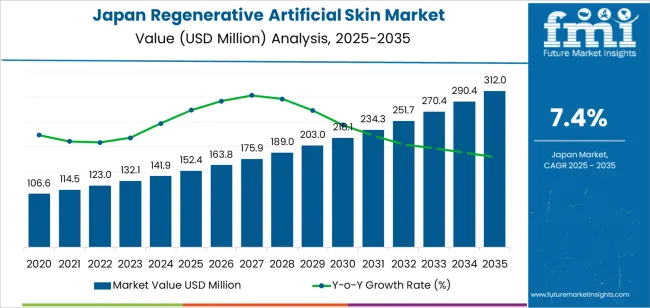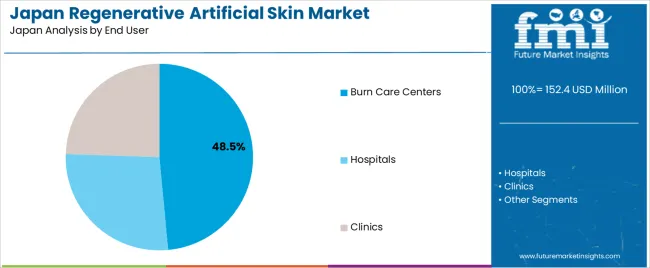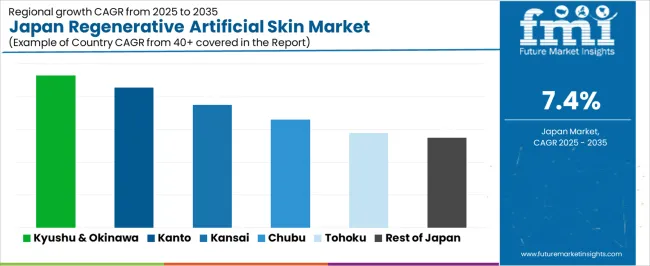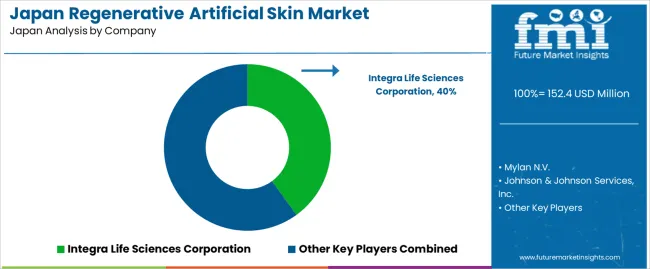The demand for regenerative artificial skin in Japan is projected to grow from USD 152.4 million in 2025 to USD 312.0 million by 2035, reflecting a CAGR of 7.4%. Regenerative artificial skin is critical for wound healing, burn treatment, and cosmetic surgeries, offering significant benefits for patients with severe burns, diabetic ulcers, and other skin-related conditions. The market growth is driven by several factors, including advancements in biotechnology, the increasing prevalence of chronic skin conditions, and rising demand for advanced treatment options that provide better healing outcomes and reduced recovery times.
Technological advancements in skin regeneration and biocompatible materials will continue to drive demand. Additionally, the growing acceptance of 3D bioprinting and stem cell therapies in medical applications is likely to contribute significantly to the expansion of regenerative skin products. As Japan’s healthcare system focuses on improving patient outcomes through innovative treatments, the demand for regenerative artificial skin will remain strong over the next decade.

The contribution of volume vs price growth analysis for regenerative artificial skin in Japan shows how the market expansion is influenced by both increased volume demand and price adjustments over the forecast period.
From 2025 to 2030, the market will grow from USD 152.4 million to USD 218.1 million, adding USD 65.7 million in value. This early growth will be primarily driven by volume growth as the demand for advanced skin treatments rises with the increasing incidence of severe burns, skin ulcers, and other skin-related conditions in Japan. The early phase will see a higher contribution from volume due to wider adoption of regenerative artificial skin products in burn care, wound healing, and cosmetic surgery. As hospitals, clinics, and cosmetic surgery centers increasingly turn to biocompatible skin solutions, the market will experience growth driven by greater usage of these products across multiple applications.
From 2030 to 2035, the market will grow from USD 218.1 million to USD 312.0 million, contributing USD 93.9 million in value. During this phase, the market will see a shift towards higher price growth, driven by advanced technologies such as stem cell-based therapies, 3D bioprinting, and other cutting-edge treatments. While volume will continue to drive market expansion, higher-quality regenerative skin products will command premium prices, reflecting advancements in material properties, technology, and patient outcomes. The increased availability of premium regenerative skin solutions that offer better precision and faster healing times will contribute to the price-driven growth during the later years. Thus, the market's growth will be driven by a balance of increasing volume demand and rising prices, as technological advancements make these treatments more effective and sought after in medical and cosmetic applications.
| Metric | Value |
|---|---|
| Sales Value (2025) | USD 152.4 million |
| Forecast Value (2035) | USD 312 million |
| Forecast CAGR (2025 to 2035) | 7.4% |
Demand for regenerative artificial skin in Japan is increasing as the incidence of burn injuries, chronic wounds, and surgical skin defects rises in an aging population. Japan’s advanced healthcare infrastructure and strong research base support adoption of artificial skin substitutes in burn centres and tertiary hospitals. The Asia Pacific region, including Japan, has been projected to account for a substantial share of the market, with around 15 % of global revenue in recent assessments. Japan’s emphasis on high-quality care and postoperative outcomes underpins the usage of engineered skin materials and bioengineered substitutes.
Another contributing factor is the advancements in biomaterials, skin-engineering technologies and regulatory pathways that facilitate deployment of innovative wound-care products. Japanese practitioners increasingly prefer solutions that shorten healing times, reduce scarring, and improve functional and cosmetic results for patients. Nonetheless, challenges remain: the high cost of advanced artificial skin products limits access, manufacturing complexity restricts widespread use, and regulatory approval processes continue to affect speed of introduction. Despite these barriers, given the clinical need and technological capability, the demand for regenerative artificial skin in Japan is expected to grow steadily.
The demand for regenerative artificial skin in Japan is primarily driven by material type and end-user segment. The leading material type is engineered skin material, which holds 33% of the market share, while burn care centers are the dominant end-user segment, accounting for 48.5% of the demand. Regenerative artificial skin is crucial in treating severe burns and other skin injuries by promoting skin regeneration and healing. The increasing prevalence of burn injuries and advancements in regenerative medicine continue to drive the demand for these innovative solutions, especially in specialized care settings like burn centers.

Engineered skin material leads the regenerative artificial skin market, capturing 33% of the demand. Engineered skin is a sophisticated, bioengineered solution that closely mimics the structure and function of natural skin. It is commonly used in treating burn victims, severe wounds, and skin defects by providing a temporary or permanent substitute for damaged skin. Engineered skin is designed to promote tissue regeneration and protect exposed tissues from infections while the body heals.
The demand for engineered skin material is growing due to its ability to facilitate faster recovery and improve outcomes compared to traditional skin grafts or bandages. It also reduces the need for repeated surgical interventions, making it a preferred choice for both patients and healthcare providers. As the need for advanced, effective treatments for burns and severe skin injuries continues to rise, engineered skin material is expected to remain a dominant and growing segment in the regenerative artificial skin market in Japan.

Burn care centers are the leading end-user segment for regenerative artificial skin in Japan, accounting for 48.5% of the demand. These specialized medical facilities focus on the treatment and rehabilitation of burn victims, making them the primary consumers of advanced skin substitutes like regenerative artificial skin. The high prevalence of burn injuries, coupled with the growing need for effective treatment options that promote healing and reduce scarring, drives the demand for these products.
Burn care centers utilize regenerative artificial skin to cover wounds, promote tissue regeneration, and reduce infection risks, all of which are crucial for effective burn management. The use of engineered or bi-layered skin materials in burn care provides patients with better outcomes and faster healing times. As Japan continues to invest in advanced medical technologies for the treatment of burn injuries, burn care centers will remain the largest driver of the regenerative artificial skin market, ensuring that this segment maintains its dominant position in the industry.

The demand for regenerative artificial skin in Japan is rising as advancements in biotechnology and wound care solutions continue to improve. Regenerative artificial skin, which can aid in the healing of severe burns, chronic wounds, and skin defects, is becoming increasingly important in the treatment of injuries and medical conditions that require skin regeneration. Japan’s aging population, high rates of burn injuries, and growing awareness of advanced wound care technologies are key drivers of the market.
Additionally, the country’s highly advanced healthcare infrastructure ensures wide access to cutting-edge treatments, further boosting the demand for regenerative artificial skin. Regional variations in demand reflect differences in healthcare access, population health, and technological adoption. Below is an analysis of the demand for regenerative artificial skin across different regions in Japan.
| Region | CAGR (2025 to 2035) |
|---|---|
| Kyushu & Okinawa | 9.3% |
| Kanto | 8.5% |
| Kinki | 7.5% |
| Chubu | 6.6% |
| Tohoku | 5.8% |
| Rest of Japan | 5.5% |
Kyushu & Okinawa leads the demand for regenerative artificial skin in Japan with a CAGR of 9.3%. The region’s aging population, coupled with a high rate of burn injuries and medical conditions requiring skin regeneration, contributes to the growing need for advanced skin solutions. Okinawa’s large elderly demographic is particularly vulnerable to chronic skin conditions, which fuels the demand for regenerative skin treatments.
Moreover, the region’s focus on holistic healthcare and the accessibility of advanced medical technologies ensure that regenerative artificial skin is readily available for patients. Kyushu & Okinawa also benefits from its position as a hub for healthcare services, with well-established hospitals and clinics providing cutting-edge treatments. As more people in the region seek effective solutions for skin regeneration, the demand for regenerative artificial skin will continue to grow rapidly.
Kanto shows strong demand for regenerative artificial skin with a CAGR of 8.5%. Kanto, home to Tokyo and its surrounding areas, has a large population and a high concentration of hospitals and medical centers specializing in advanced treatments. The region’s aging population, along with increasing awareness about advanced wound care, drives the demand for regenerative skin solutions. The prevalence of chronic conditions and burn injuries further contributes to this growth.
Kanto’s healthcare infrastructure is well-developed, with hospitals adopting the latest technologies to treat skin-related issues. The region’s focus on innovation and access to high-quality healthcare ensures a continued rise in the demand for regenerative artificial skin. As more patients seek out advanced solutions for skin regeneration, Kanto’s market for these products remains robust.
Kinki, with a CAGR of 7.5%, shows steady demand for regenerative artificial skin. The region includes major cities like Osaka, which are home to a significant portion of Japan’s aging population. As in other regions, the need for advanced skin regeneration solutions is driven by the rising incidence of burn injuries and chronic skin conditions, particularly among older adults.
Kinki’s healthcare infrastructure, with numerous specialized medical centers, facilitates the adoption of regenerative skin solutions. However, growth is slightly slower than in Kyushu & Okinawa and Kanto, likely due to a combination of factors such as the region’s more mature healthcare market and fewer large-scale specialized treatments. Despite this, Kinki remains an important market for regenerative artificial skin, and its steady demand will continue as the population ages and the demand for advanced wound care solutions rises.
Chubu demonstrates moderate growth in the demand for regenerative artificial skin, with a CAGR of 6.6%. Chubu, including Nagoya and surrounding areas, has a strong industrial base and a growing healthcare sector. The demand for regenerative artificial skin in this region is driven by an aging population and an increase in the number of people suffering from chronic wounds, burns, and other skin conditions that require advanced medical treatments.
Although the market in Chubu is growing at a slower pace compared to Kyushu & Okinawa and Kanto, the region’s focus on healthcare innovation and expanding access to medical treatments will support steady growth in the demand for regenerative artificial skin. As more people in Chubu seek solutions for skin regeneration, the market will continue to show positive growth.
Tohoku, with a CAGR of 5.8%, and the Rest of Japan, with a CAGR of 5.5%, show slower growth in the demand for regenerative artificial skin compared to other regions. These areas are more rural and less industrialized, with fewer healthcare facilities specializing in advanced treatments for skin regeneration. The demand is still present but is largely driven by the elderly population and those with specific health conditions, such as burn injuries or chronic skin issues.
While the healthcare infrastructure in these regions is improving, the adoption of regenerative artificial skin is more gradual due to lower levels of awareness, fewer specialized medical centers, and a less urbanized population. However, as access to advanced treatments improves and the population continues to age, the demand for regenerative artificial skin in Tohoku and the Rest of Japan is expected to grow steadily over time.

Demand for regenerative artificial skin in Japan is increasing as hospitals and specialty clinics adopt advanced wound-care solutions for burns, traumatic injuries, chronic ulcers and reconstructive procedures. Companies such as Integra Life Sciences Corporation with an estimated 40% share, Johnson & Johnson Services, Inc., Smith & Nephew and Mallinckrodt Plc. are key participants in this industry. Growth is supported by Japan’s aging population, rising incidence of diabetes-related wounds and continued investment in bioengineered tissue technologies that offer predictable healing and reduced infection risk.
Competition in this industry centers on material science, clinical performance and ease of surgical handling. Firms refine collagen matrices, bilayer scaffolds and synthetic composite structures to enhance cell adhesion and vascularization. Another strategy focuses on expanding clinical indications, with products designed for burns, pressure ulcers, surgical defects and cosmetic reconstruction. Companies also work to simplify application techniques through pre-shaped sheets and ready-to-use formats that reduce operating time.
Product brochures typically highlight structural composition, porosity, handling properties and supporting clinical evidence. By aligning these attributes with hospital priorities such as reliable integration, reduced complications and efficient workflow, companies aim to strengthen their position in the Japanese regenerative artificial skin industry.
| Items | Details |
|---|---|
| Quantitative Units | USD Million |
| Regions Covered | Japan |
| Material | Engineered Skin Material, Temporary Skin Material, Single Layer Material, Bi-layered Material, Permanent Skin Material |
| End User | Burn Care Centers, Hospitals, Clinics |
| Key Companies Profiled | Integra Life Sciences Corporation, Johnson & Johnson Services, Inc., Smith & Nephew, Mallinckrodt Plc. |
| Additional Attributes | The market analysis includes dollar sales by material type and end-user categories. It also covers regional demand trends in Japan, driven by the increasing use of regenerative artificial skin for burn care and wound healing. The competitive landscape highlights key manufacturers focusing on innovations in skin regeneration technologies and materials. Trends in the growing demand for advanced wound care products and the adoption of bi-layered and permanent skin materials are explored, along with advancements in bioengineered skin and treatment solutions. |
The global demand for regenerative artificial skin in japan is estimated to be valued at USD 152.4 million in 2025.
The market size for the demand for regenerative artificial skin in japan is projected to reach USD 312.0 million by 2035.
The demand for regenerative artificial skin in japan is expected to grow at a 7.4% CAGR between 2025 and 2035.
The key product types in demand for regenerative artificial skin in japan are engineered skin material, temporary skin material, single layer material, bi-layered material and permanent skin material.
In terms of end user, burn care centers segment to command 48.5% share in the demand for regenerative artificial skin in japan in 2025.






Our Research Products

The "Full Research Suite" delivers actionable market intel, deep dives on markets or technologies, so clients act faster, cut risk, and unlock growth.

The Leaderboard benchmarks and ranks top vendors, classifying them as Established Leaders, Leading Challengers, or Disruptors & Challengers.

Locates where complements amplify value and substitutes erode it, forecasting net impact by horizon

We deliver granular, decision-grade intel: market sizing, 5-year forecasts, pricing, adoption, usage, revenue, and operational KPIs—plus competitor tracking, regulation, and value chains—across 60 countries broadly.

Spot the shifts before they hit your P&L. We track inflection points, adoption curves, pricing moves, and ecosystem plays to show where demand is heading, why it is changing, and what to do next across high-growth markets and disruptive tech

Real-time reads of user behavior. We track shifting priorities, perceptions of today’s and next-gen services, and provider experience, then pace how fast tech moves from trial to adoption, blending buyer, consumer, and channel inputs with social signals (#WhySwitch, #UX).

Partner with our analyst team to build a custom report designed around your business priorities. From analysing market trends to assessing competitors or crafting bespoke datasets, we tailor insights to your needs.
Supplier Intelligence
Discovery & Profiling
Capacity & Footprint
Performance & Risk
Compliance & Governance
Commercial Readiness
Who Supplies Whom
Scorecards & Shortlists
Playbooks & Docs
Category Intelligence
Definition & Scope
Demand & Use Cases
Cost Drivers
Market Structure
Supply Chain Map
Trade & Policy
Operating Norms
Deliverables
Buyer Intelligence
Account Basics
Spend & Scope
Procurement Model
Vendor Requirements
Terms & Policies
Entry Strategy
Pain Points & Triggers
Outputs
Pricing Analysis
Benchmarks
Trends
Should-Cost
Indexation
Landed Cost
Commercial Terms
Deliverables
Brand Analysis
Positioning & Value Prop
Share & Presence
Customer Evidence
Go-to-Market
Digital & Reputation
Compliance & Trust
KPIs & Gaps
Outputs
Full Research Suite comprises of:
Market outlook & trends analysis
Interviews & case studies
Strategic recommendations
Vendor profiles & capabilities analysis
5-year forecasts
8 regions and 60+ country-level data splits
Market segment data splits
12 months of continuous data updates
DELIVERED AS:
PDF EXCEL ONLINE
Demand Signal Repository Solutions Market Size and Share Forecast Outlook 2025 to 2035
Demand Side Management Market Size and Share Forecast Outlook 2025 to 2035
Demand Response Market Analysis - Size, Share, and Forecast Outlook 2025 to 2035
North America Shipping Supplies Market Trends – Innovations & Growth 2024-2034
Demand of Kozani Saffron in Greece Analysis - Size, Share & Forecast 2025 to 2035
Demand of No-acid Whey Strained Dairy Processing Concepts in European Union Size and Share Forecast Outlook 2025 to 2035
Demand for Bronte Pistachio in Italy Analysis - Size, Share & Forecast 2025 to 2035
Demand and Trend Analysis of Gaming Monitor in Western Europe Size and Share Forecast Outlook 2025 to 2035
Demand and Trend Analysis of Gaming Monitor in Korea Size and Share Forecast Outlook 2025 to 2035
Demand and Trend Analysis of Gaming Monitor in Japan Size and Share Forecast Outlook 2025 to 2035
Glycine Soja (Soybean) Seed Extract Market Size and Share Forecast Outlook 2025 to 2035
Demand and Trend Analysis of Yeast in Japan - Size, Share, and Forecast Outlook 2025 to 2035
Demand of Pistachio-based desserts & ingredients in France Analysis - Size, Share & Forecast 2025 to 2035
Demand and Trends Analysis of Stevia in Japan Size and Share Forecast Outlook 2025 to 2035
Japan Women’s Intimate Care Market Trends – Growth & Forecast 2024-2034
Demand and Trend Analysis of Fabric Stain Remover in Korea Size and Share Forecast Outlook 2025 to 2035
Demand and Sales Analysis of Paper Cup in Korea Size and Share Forecast Outlook 2025 to 2035
Demand and Sales Analysis of Paper Cup in Western Europe Size and Share Forecast Outlook 2025 to 2035
Demand of MFGM-enriched Powders & RTDs in European Union Size and Share Forecast Outlook 2025 to 2035
Demand and Sales Analysis of Paper Cup in Japan Size and Share Forecast Outlook 2025 to 2035

Thank you!
You will receive an email from our Business Development Manager. Please be sure to check your SPAM/JUNK folder too.
Chat With
MaRIA